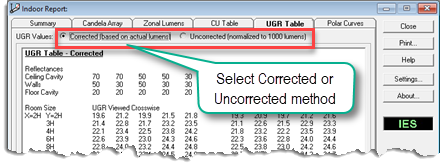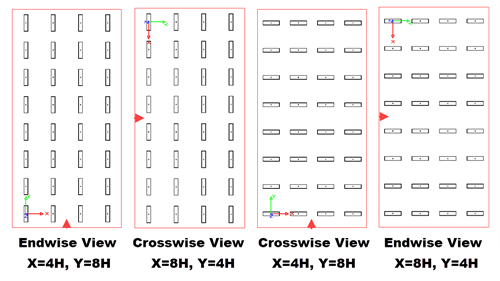

IES Indoor Report UGR Table
Unified Glare Rating (UGR) is a psychological measure of Discomfort Glare in interior lighting applications. It can be calculated precisely for a specific lighting arrangement using AGi32, or can be summarized for typical scenarios by a table as displayed in Photometric Toolbox. UGR is defined by document CIE 117-1995, Discomfort Glare in Interior Lighting, and clarified in terms of the tabular display in CIE 190:2010, Calculation and Presentation of Unified Glare Rating Tables for Indoor Lighting Luminaires.
Tabular data can be displayed in an "Uncorrected" or "Corrected" format. Uncorrected data is displayed per 1000 lumens. Corrected data is displayed per the actual luminaire lumen output. Photometric Toolbox can display the data using either method. The selection is made at the top of the dialog where the tabular data will immediately change to reflect the selection.

The last selected method will be recorded in the Settings (Settings button) and will be used for subsequent files. The default selection is corrected data. Corrected data will more closely resemble the actual calculations when performed in AGi32 as it is based on the actual luminaire lumen output. Uncorrected data should be used to compare with European-sourced information where the normalization of data per 1000 lumens is common. Normalizing (uncorrected data) is useful for comparing relative performance between luminaires by assuming they have identical lumen output (1000).
The UGR rating scale has a practical range of 10 to 30 (unitless). The higher the number the more likely the luminaire will cause discomfort glare. Values less then ten indicate little to no glare. The intention of the tabular method of UGR calculation is to provide an easy way to compare different luminaires as applied in a typical uniform layout.
UGR is a function of luminaire luminance in the offending zones, background luminance and room size. Luminaires with greater high angle brightness in rooms with low surface reflectances will typically produce the highest UGR values. Larger rooms typically produce higher UGR as there are more sources in the observer's field of view.
The Maximum UGR value from the table is displayed at the bottom. This is a theoretical maximum based on the assumptions used to render the table of values. It may not be the actual maximum for unusual luminaire arrangements, very low reflectances or very large rooms when calculate precisely using AGi32.
Limitations:
Reading the UGR Table
Assumptions:
The calculation of UGR is independent of the height of the luminaires above the observer's eye (H) and luminaire spacing (also = H). As H changes the size of the room and spacing of the luminaires will change as well.
A typical corrected UGR table is shown below. Follow these steps to determine the UGR value:


* Cavity reflectances must be determined from a cavity reflectance table according to the formula for the cavity reflectance (see the IES handbook). This is not often necessary as the floor cavity (floor to work plane) is always 20% in the table. The ceiling cavity reflectance is only different from the actual ceiling reflectance if the luminaires are suspended. In this case, due to the broad nature of the table values it is typically safe to simply use the ceiling reflectance value, or drop down by one column from the actual reflectance as a conservative rule of thumb.